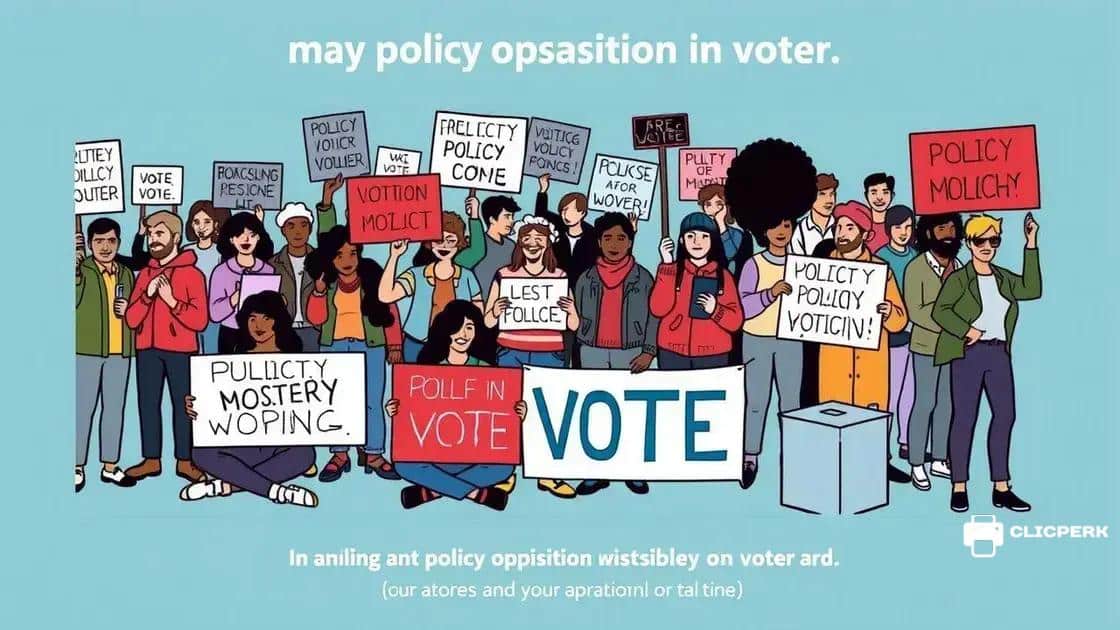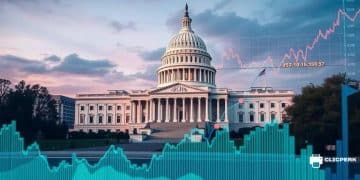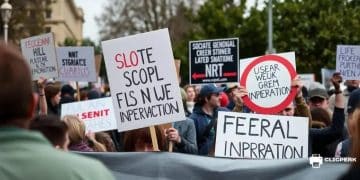Trump administration policy opposition: what you need to know

The opposition to Trump administration policies on immigration, healthcare, and environmental issues significantly increased voter engagement and activism, shaping the future of American politics and influencing party dynamics.
Trump administration policy opposition significantly shaped the political landscape in the U.S. It sparked passionate debates and mobilized diverse groups against certain policies. What does this mean for the future?
Understanding the core policies of the Trump administration
Understanding the core policies of the Trump administration is essential for grasping its impact on American society. These policies range from immigration reform to tax cuts, each leaving a significant mark on various aspects of governance.
One of the pivotal areas is immigration. The administration emphasized stricter border controls and policies that aimed at reducing illegal immigration. This focus generated extensive debate among supporters who favored security and critics who argued for a more humanitarian approach.
Key Economic Policies
The economic policies implemented during this period aimed to boost job growth and stimulate investment. Measures such as tax cuts for individuals and corporations were pivotal. Many believed these cuts spurred economic growth, while others questioned their effectiveness in promoting long-term prosperity.
- Reduction of corporate tax rates.
- Focus on deregulation to support businesses.
- Investment in infrastructure projects.
Another critical policy area was healthcare. The Trump administration took major steps to repeal and replace the Affordable Care Act (ACA). This move was controversial and sparked widespread discussion about the future of healthcare in America. Advocates believed a repeal could lower costs, while opponents feared it would strip millions of their health coverage.
Foreign Policy Highlights
On the foreign policy front, the administration pursued an ‘America First’ strategy. This approach aimed to prioritize U.S. interests in trade agreements and international agreements. For example, renegotiating NAFTA into the USMCA was a significant shift intended to benefit American workers.
- Withdrawal from the Paris Agreement on climate change.
- Decisions on tariffs against China.
- Strengthening ties with Israel and negotiating peace agreements.
These core policies reflect a distinct shift in political strategy and ideology, highlighting the various facets of governance under the Trump administration. By examining these policies, we can better comprehend the administration’s legacy and its relevance in ongoing political discussions.
Major areas of opposition and resistance
Throughout the Trump administration, several major areas of opposition and resistance emerged, reflecting the public’s response to various policies. One notable area was immigration, where policies like the travel bans prompted significant protests and legal challenges. These actions stirred emotions and debates across the nation, highlighting the deep divide on this issue.
The handling of immigration issues, such as family separations at the border, ignited outrage. Many activists and organizations mobilized to advocate for immigrant rights, creating movements that drew attention and support nationwide.
Healthcare Policy Resistance
Another critical area of resistance revolved around healthcare policy. The Trump administration aimed to repeal the Affordable Care Act (ACA), which faced fierce opposition. Many Americans relied on the ACA for insurance coverage, and efforts to remove it prompted rallies and campaigns to protect this healthcare access.
- Grassroots movements fought to maintain the ACA for millions.
- Public opinion polls showed significant concern about losing healthcare coverage.
- Activists organized marches and online campaigns advocating for accessible healthcare.
The proposed changes caused anxiety among various communities, particularly those vulnerable to losing coverage. This resistance highlighted the importance of healthcare in political discourse, affecting how many viewed the administration’s overall agenda.
Environmental Policies
Environmental policies also sparked significant opposition. The decision to withdraw from the Paris Agreement was met with backlash from environmental groups and concerned citizens. Activists believed this withdrawal would negatively impact global climate efforts, prompting movements geared toward protecting the environment.
- Local protests emerged advocating for sustainable practices.
- Some cities pledged to uphold climate goals despite federal policies.
- Public campaigns raised awareness about climate change impacts.
The ongoing debates and resistance surrounding these policies reflect a broader struggle over the direction in which the U.S. should go. People on both sides of the aisle have passionately voiced their opinions, showcasing the active role of citizens in holding the government accountable. This dynamic creates a landscape where dialogue continues to evolve as reactions to these policies unfold.
Impact of policy opposition on voters

The impact of policy opposition on voters during the Trump administration was significant. As various policies sparked debates, many voters felt compelled to take a stand. This activism influenced voting behaviors and shaped the outcomes of important elections.
Many individuals became more politically engaged, participating in rallies and town hall meetings to express their views. A direct effect of this mobilization was increased turnout in elections, as voters sought to counteract policies they disagreed with.
Shifts in Public Opinion
Polling data during this period showed notable shifts in public opinion regarding key issues. For example, attitudes towards immigration hardened among some demographics, while others advocated for more compassionate approaches. This divergence reflected a nation divided, with voters weighing these issues heavily when casting their ballots.
- Increased support for political candidates who aligned with activist movements.
- Changes in voting patterns by demographic groups based on policy positions.
- Heightened discussions around social justice and healthcare, tying policy opposition to electoral choices.
Moreover, the rise of social media facilitated the spread of information and mobilization efforts. Activists utilized platforms to share their messages and engage voters, creating an online community united in their opposition to specific policies. This grassroots organizing transformed how candidates reached out to voters.
Long-term Political Consequences
The ongoing opposition to Trump-era policies has potential long-term consequences for American politics. Many analysts believe that the heightened activism could reshape party dynamics, encouraging both major parties to address the concerns that many voters raised. This shift could lead to the emergence of new candidates and strategies aimed at engaging a more diverse electorate.
- Potential for third-party movements arising from dissatisfaction with the major parties.
- Increased focus on outreach to young voters who prioritize social issues.
- Changes in legislative priorities based on public sentiment and activism.
As voters continue to resist policies, their engagement will likely play a crucial role in future elections, driving discussions around governance and representation.
Reactions from political analysts and commentators
The reactions from political analysts and commentators regarding the Trump administration were diverse and often polarized. Many analysts provided critical assessments of policies, while others praised certain actions as bold and necessary. This discourse contributed to a broader understanding of the political landscape during this period.
Experts frequently debated the implications of major policies, such as immigration reform and tax changes, analyzing their potential long-term effects. Commentators often used various media platforms to share insights, leading to extensive public discussions.
Critical Assessments
Numerous analysts voiced strong opposition to several key policies. For instance, the handling of immigration laws drew fierce criticism. Many commentators argued that the administration’s stance created a humanitarian crisis at the border, raising ethical concerns about family separations.
- Analysts highlighted negative public opinion trends as a result of these policies.
- Commentators emphasized the need for comprehensive immigration reform.
- Expert warnings pointed to potential repercussions for Republican candidates in upcoming elections.
In contrast, some political commentators defended certain policies, asserting that they were necessary for national security. This division in viewpoints underscored the complexity of political analysis during the administration.
Supportive Perspectives
Supporters of the Trump administration’s policies argued that deregulation and tax cuts fostered economic growth. Commentators pointed to improved job numbers and increased consumer confidence as evidence of successful governance. Analysts often highlighted how these policies resonated with certain voter bases, reinforcing support among Republicans.
- Supporters claimed that reducing business regulations led to job creation.
- Many analysts noted a surge in stock market performance during this time.
- Arguments were made for the importance of prioritizing American interests in trade deals.
This mix of reactions from political analysts and commentators shaped public perception and discourse. Their insights played a significant role in influencing voter opinions and attitudes toward the administration’s actions.
Future implications for American politics
The future implications for American politics following the Trump administration are complex and significant. As political engagement grows, many analysts predict shifts in party dynamics and voter behavior. The polarization witnessed during this period may have lasting effects on how politics is conducted in the United States.
Increased activism is one outcome that could shape future elections. Many voters have become more aware of political issues, leading to greater participation in campaigns and advocacy efforts. This trend suggests that future elections may feature more grassroots movements aimed at influencing policy.
Shifts in Voter Demographics
Another important factor is the changing demographics of American voters. As younger generations become more involved in politics, their perspectives on key issues such as climate change, immigration reform, and healthcare will likely impact party platforms. Candidates may need to adapt their messages to resonate with these new voters.
- Young voters are increasingly prioritizing social justice and environmental issues.
- Diverse voter bases are influencing both major parties to broaden their appeal.
- The rise of independent and third-party candidates may disrupt traditional voting patterns.
Additionally, ongoing policy opposition can lead to new coalitions forming within the political landscape. Alignments based on shared interests, such as environmental advocacy or healthcare access, may arise, compelling parties to reevaluate their strategies and positions. This evolution can create new dynamics in legislative processes and political negotiations.
Impact on Political Dialogue
The discourse surrounding politics is also likely to change. As more individuals engage in debates about policy, the expectation for transparency and accountability in government may grow. This shift could lead to heightened scrutiny of political leaders and their decisions, fostering a culture that demands responsiveness and transparency.
- Increased use of social media platforms for political discourse.
- Greater public demand for fact-checking and truth in reporting.
- Potential for more civic education efforts encouraging informed participation.
The outcomes of these implications will shape the governance and political climate in the years ahead. As the American public continues to voice their opinions and influence policy, the nature of politics will adapt and evolve, reflecting the diverse values and priorities of its citizens.
In summary, the political landscape shaped by the Trump administration continues to evolve. With increasing activism and participation, voters are more engaged than ever. As demographics shift, political dialogue is set to change, making room for new perspectives. The ongoing reactions to policies signify that future elections will reflect a broader range of voices. Understanding these dynamics is crucial as they shape American politics moving forward.
FAQ – Frequently Asked Questions about the Trump Administration’s Policies
What were the key areas of opposition during the Trump administration?
Major areas of opposition included immigration policies, healthcare reform, and environmental regulations, which prompted significant public and political backlash.
How did voter engagement change during the Trump administration?
Voter engagement increased significantly, with more citizens becoming active in protests, advocacy groups, and elections, driven by strong reactions to policies.
What impact did social media have on political discourse?
Social media allowed for rapid sharing of information and mobilization of activists, leading to increased awareness and participation in political discussions.
What are the future implications of these policies for American politics?
The lasting implications include shifts in party dynamics, changes in voter demographics, and a potential increase in grassroots movements influencing elections.





